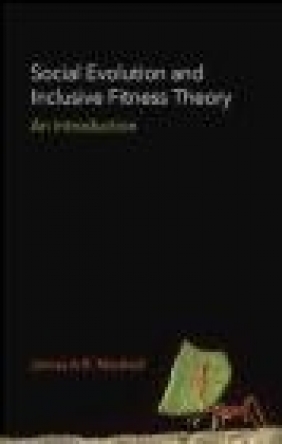Social Evolution and Inclusive Fitness Theory
James Marshall
Social Evolution and Inclusive Fitness Theory
James Marshall
- Wydawnictwo: Princeton University Press
- Rok wydania: 2015
- ISBN: 9780691161563
- Ilość stron: 216
- Oprawa: Twarda
Niedostępna
Opis: Social Evolution and Inclusive Fitness Theory - James Marshall
Social behavior has long puzzled evolutionary biologists, since the classical theory of natural selection maintains that individuals should not sacrifice their own fitness to affect that of others. Social Evolution and Inclusive Fitness Theory argues that a theory first presented in 1963 by William D. Hamilton-inclusive fitness theory-provides the most fundamental and general explanation for the evolution and maintenance of social behavior in the natural world. James Marshall guides readers through the vast and confusing literature on the evolution of social behavior, introducing and explaining the competing theories that claim to provide answers to questions such as why animals evolve to behave altruistically. Using simple statistical language and techniques that practicing biologists will be familiar with, he provides a comprehensive yet easily understandable treatment of key concepts and their repeated misinterpretations. Particular attention is paid to how more realistic features of behavior, such as nonadditivity and conditionality, can complicate analysis. Marshall highlights the general problem of identifying the underlying causes of evolutionary change, and proposes fruitful approaches to doing so in the study of social evolution. Social Evolution and Inclusive Fitness Theory describes how inclusive fitness theory addresses both simple and complex social scenarios, the controversies surrounding the theory, and how experimental work supports the theory as the most powerful explanation for social behavior and its evolution. "Overall, this useful little book provides a superlative introduction to the core mathematics one needs to understand the quantitative basis of sociobiology."--ChoiceList of Figures xi List of Tables xii Preface xiii Acknowlegments xvii 1 SOCIAL BEHAVIOR AND EVOLUTIONARY THOUGHT 1 1.1 Explanations for Apparent Design 1 1.2 Natural Selection and Social Behavior 3 1.3 Arguments for Group Benefit 7 1.4 Enter Hamilton 11 1.5 Multilevel Selection Theory 13 1.6 The Generality of Inclusive Fitness Theory 14 2 MODELS OF SOCIAL BEHAVIOR 16 2.1 Introduction 16 2.2 The Donation Game 18 2.3 The Nonadditive Donation Game 22 2.4 Other Social Interactions 25 2.5 Public Goods Games 28 2.6 Threshold Public Goods Games 29 2.7 Interactions in Structured Populations 32 2.8 Summary 32 3 THE PRICE EQUATION 34 3.1 A General Description of Selection 34 3.2 Genetic Selection 36 3.3 Illustrative Applications of the Price Equation 39 3.4 Important Caveats 43 3.5 Summary 45 4 INCLUSIVE FITNESS AND HAMILTON'S RULE 46 4.1 Inclusive Fitness Extends Classical Darwinian Fitness 46 4.2 Fitness Effects as Regression on Genes 47 4.3 Deriving Hamilton's Rule in the Simplest Case 51 4.4 Perceived Limitations of Inclusive Fitness Theory 54 4.5 Summary 58 5 NONADDITIVE INTERACTIONS AND HAMILTON'S RULE 59 5.1 Replicator Dynamics for Interactions between Relatives 59 5.2 Extending Hamilton's Rule to Deal with Nonadditivity 65 5.3 The Price Equation and Levels of Causal Analysis 69 5.4 Summary 70 6 CONDITIONAL BEHAVIORS AND INCLUSIVE FITNESS 71 6.1 Implicit and Explicit Conditionality 71 6.2 Modeling Conditional Behavior 73 6.3 Claims That Assortment Is More Fundamental Than Relatedness 76 6.4 Summary 77 7 VARIANTS OF HAMILTON'S RULE AND EVOLUTIONARY EXPLANATIONS 78 7.1 Variants of Hamilton's Rule 78 7.2 Geometric Relatedness Underlies Phenotypic Assortment 83 7.3 Explanations for Greenbeards 86 7.4 Different Viewpoints on Conditional Traits 88 7.5 Summary 89 8 HERITABILITY, MAXIMIZATION, AND EVOLUTIONARY EXPLANATIONS 90 8.1 What Drives Social Evolution? 90 8.2 Selection and Heritability 90 8.3 Do Individuals Act to Maximize Their Inclusive Fitness? 95 8.4 Ultimate Causes and Social Evolution 97 8.5 Summary 103 9 WHAT IS FITNESS? 105 9.1 Introduction 105 9.2 Haldane's Dilemma 105 9.3 Reproductive Value and Class Structure 107 9.4 Fitness, Fecundity, and Payoffs 109 9.5 Summary 114 10 EVIDENCE, OTHER APPROACHES, AND FURTHER TOPICS 115 10.1 Introduction 115 10.2 Empirical Support for Inclusive Fitness Theory 115 10.3 Some Further Topics in Social Evolution Theory 127 10.4 Other Theoretical Approaches 129 10.5 Conclusion 132 Glossary 135 Notes 139 Bibliography 175 Index 187
Szczegóły: Social Evolution and Inclusive Fitness Theory - James Marshall
Tytuł: Social Evolution and Inclusive Fitness Theory
Autor: James Marshall
Wydawnictwo: Princeton University Press
ISBN: 9780691161563
Rok wydania: 2015
Ilość stron: 216
Oprawa: Twarda
Waga: 0.49 kg




























